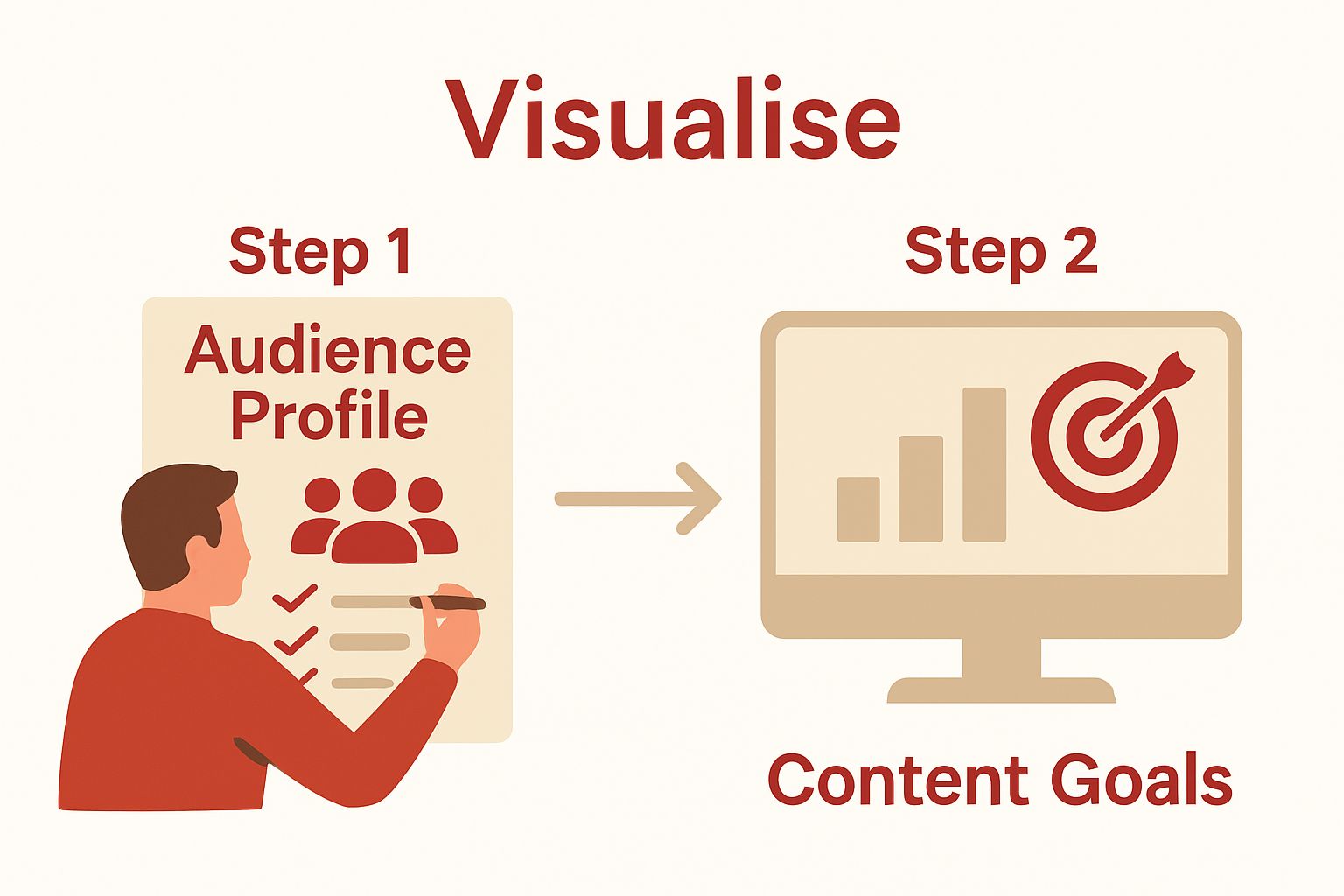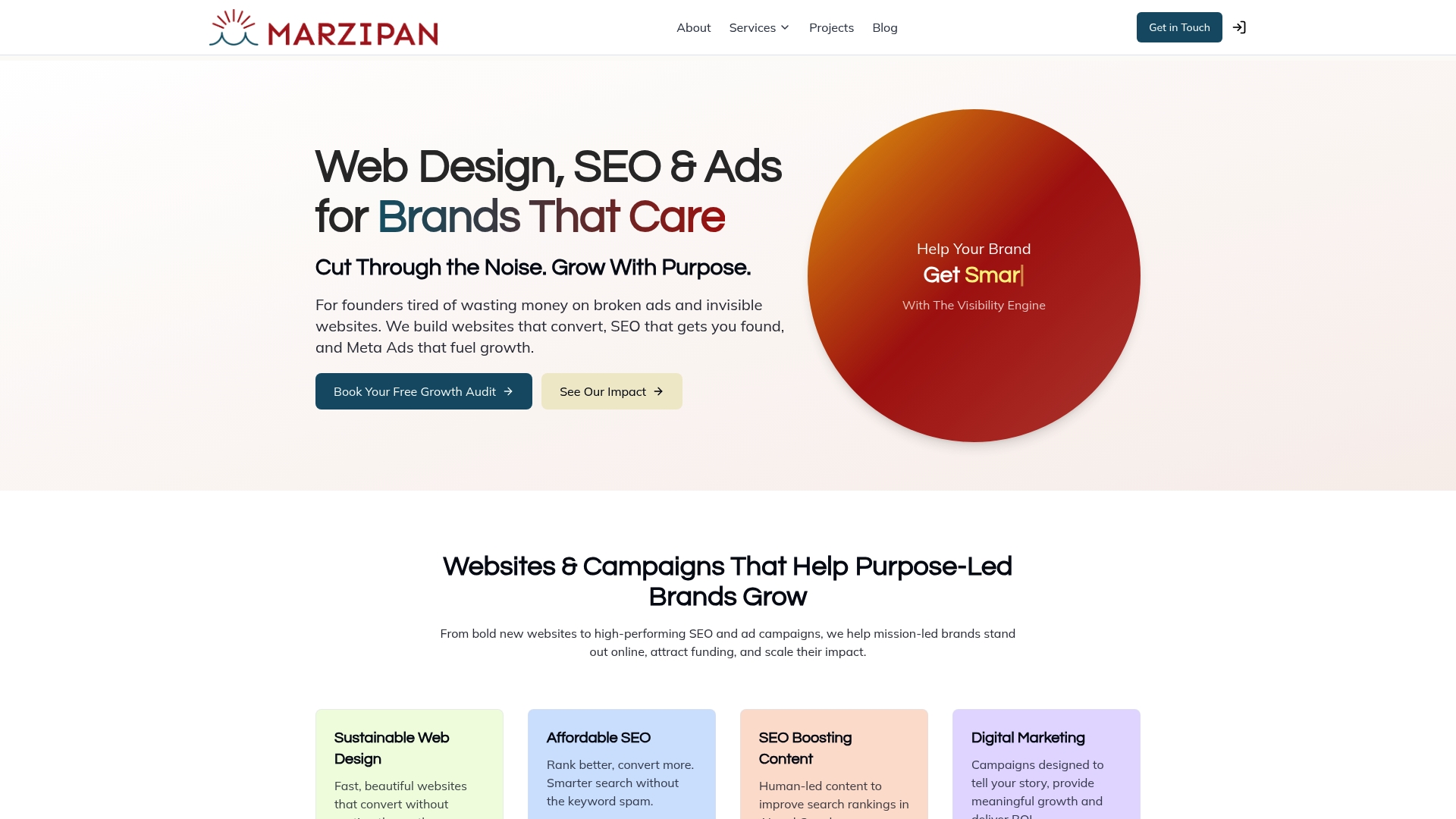How to Plan Website Content Effectively for Success
Planning website content might sound straightforward and even a bit dull at first glance. Yet, the difference between average and outstanding content often comes down to understanding your audience on a much deeper level. When you realise that personalised website content can improve engagement by up to 50 percent, it suddenly becomes clear that thoughtful planning is not just helpful but absolutely transformative.
Table of Contents
- Step 1: Define Your Target Audience And Goals
- Step 2: Conduct A Content Audit And Research Keywords
- Step 3: Create A Content Plan And Outline Structure
- Step 4: Develop Engaging And Valuable Content
- Step 5: Review, Test, And Optimise Content Before Publishing
Quick Summary
| Key Point | Explanation |
|---|---|
| 1. Define your audience comprehensively | Create detailed personas that reflect audience motivations and challenges for effective content creation. |
| 2. Establish SMART content goals | Ensure your content objectives are Specific, Measurable, Achievable, Relevant, and Time-bound to guide development. |
| 3. Conduct thorough content audits | Regularly review existing content to identify gaps and optimise materials based on audience needs and keyword research. |
| 4. Develop a detailed content plan | Use a structured calendar to organise topics, formats, and goals, ensuring a balanced approach to content types. |
| 5. Implement a rigorous review process | Perform thorough reviews of content for quality and technical optimisation before publishing to maximise audience engagement. |
Step 1: Define your target audience and goals
Understanding your target audience and establishing clear goals are foundational steps in planning effective website content. Before creating a single paragraph, you must develop a comprehensive understanding of who you are speaking to and what precise outcomes you want to achieve.
Identifying Your Target Audience
Successful website content begins with deep audience insight. Start by developing detailed audience personas that go beyond basic demographics. Consider their professional challenges, personal motivations, online behaviours, and specific pain points. Research shows that personalised content can improve engagement by up to 50%, making audience understanding crucial.
To build accurate personas, gather information through multiple channels. Conduct surveys with existing customers, analyse website analytics, review social media interactions, and examine customer support inquiries. Look for patterns in age groups, professional backgrounds, interests, and communication preferences. This granular understanding will help you craft content that resonates deeply and speaks directly to your audience’s needs.
Setting Strategic Content Goals
With a clear audience profile, define specific, measurable goals for your website content. These objectives should align with broader business strategies and address your audience’s requirements. Goals might include increasing brand awareness, generating leads, educating potential customers, or establishing thought leadership in your industry.
Each content goal requires a tailored approach. For lead generation, focus on creating compelling, actionable content with clear conversion pathways. If your aim is education, develop in-depth, authoritative resources that demonstrate expertise. Whatever your objectives, ensure they are SMART goals: Specific, Measurable, Achievable, Relevant, and Time-bound.
By meticulously defining your target audience and establishing precise content goals, you create a strategic foundation that will guide every subsequent content development decision.
 This initial groundwork transforms website content from generic communication to targeted, purposeful messaging that genuinely connects with your intended readers.
This initial groundwork transforms website content from generic communication to targeted, purposeful messaging that genuinely connects with your intended readers.
Step 2: Conduct a content audit and research keywords
After defining your target audience, the next critical step in website content planning involves thoroughly examining your existing content and uncovering strategic keywords that will drive meaningful engagement. This comprehensive process helps identify content gaps, optimise existing materials, and ensure your website speaks directly to audience search intentions.
Begin your content audit by systematically reviewing all existing website pages, blog posts, and digital assets. Use spreadsheet tools to catalogue each piece of content, tracking critical metrics like publication date, current performance, relevance to target audience, and search engine rankings. Learn more about conducting an effective SEO audit to understand how deep analysis can transform your content strategy.
Analysing Existing Content
Carefully evaluate each content piece against your newly established audience personas and strategic goals. Determine which materials remain relevant and which require updating or complete replacement. Look for content that no longer serves your brand’s messaging or fails to address your audience’s current needs. Some materials might need substantial rewrites, while others could be consolidated or archived.
Keyword research becomes the compass guiding your content refinement process. Utilise professional tools like SEMrush, Ahrefs, or Google Keyword Planner to discover search terms your target audience uses. Focus on long-tail keywords that demonstrate specific user intent rather than broad, competitive phrases. Analyse search volume, keyword difficulty, and potential traffic potential for each term.
Strategic Keyword Integration
Transform your keyword research into a strategic content roadmap. Identify opportunities to create new content that directly addresses audience search queries. Prioritise keywords with reasonable competition and clear alignment with your brand’s expertise. This approach ensures your content not only attracts traffic but provides genuine value to readers.
Successful content audits and keyword research require patience and precision. By meticulously reviewing existing materials and understanding audience search behaviours, you create a strong foundation for a website content strategy that resonates powerfully with your target demographic. The insights gained during this step will directly inform your upcoming content creation and optimization efforts.
Step 3: Create a content plan and outline structure
With your audience defined and keywords researched, developing a structured content plan becomes the strategic blueprint that transforms your insights into actionable content. This critical phase involves crafting a comprehensive roadmap that aligns your content creation efforts with your established goals and audience requirements.
Developing Your Content Architecture
Begin by creating a detailed content calendar that maps out topics, publication dates, and primary objectives for each piece. This living document should reflect the keyword research completed in the previous step, ensuring each content asset serves a specific strategic purpose. Learn more about developing comprehensive content strategies to refine your approach.
Organise your content plan across multiple dimensions. Consider content types that will resonate with your audience, including blog posts, guides, case studies, videos, and infographics. Each content type should address different stages of the audience journey, from initial awareness to detailed consideration and final conversion. Prioritise creating a balanced mix that provides value at every interaction point.
Structuring Individual Content Pieces
For each planned content piece, develop a robust outline that provides clear direction and maintains consistency. A strong outline typically includes a compelling headline, key section headers, primary messaging points, and specific keywords to incorporate. Think of your outline as a skeletal framework that guides writers while ensuring the content remains focused and purposeful.
Consider your audience’s information consumption preferences when designing content structure. Modern readers appreciate scannable content with clear headings, concise paragraphs, and visual breaks. Incorporate elements like subheadings, bullet points, and relevant images to enhance readability and engagement. Your outline should anticipate how readers will interact with the content, making information accessible and digestible.
Remember that a content plan is not a rigid document but a flexible strategy. Build in regular review points to assess performance, adjust topics based on audience response, and realign with evolving business objectives. By creating a dynamic, thoughtful content structure, you establish a framework that supports consistent, high-quality content production that genuinely serves your audience’s needs.

Step 4: Develop engaging and valuable content
Transforming your strategic content plan into compelling, high-quality content requires a nuanced approach that balances creativity with precise audience targeting. This step moves beyond mere writing, focusing on crafting narratives that genuinely connect with your intended readers while delivering substantive value. Explore our comprehensive guide on creating impactful branded content to understand the deeper principles of effective communication.
Crafting Audience-Centric Content
Successful content development starts with a profound understanding of your audience’s core needs and challenges. Each piece must solve a specific problem, answer a critical question, or provide unique insights that differentiate your brand from competitors. Writing should feel like a direct conversation, using language that resonates with your target demographic’s professional and personal context.
Approach content creation as a strategic storytelling exercise. Authenticity and clarity are paramount. Use clear, concise language that communicates complex ideas without unnecessary jargon. Structure your content with a logical flow that guides readers naturally from introduction to conclusion, maintaining engagement through thoughtful narrative techniques.
Quality and Optimization Strategies
Ensure every content piece undergoes rigorous quality checks. Beyond grammatical perfection, evaluate each draft against key criteria: Does it answer the audience’s primary questions? Does it align with your established content goals? Does it provide actionable, practical insights? Incorporate relevant keywords naturally, avoiding forced or repetitive language that might compromise readability.
Consider diversifying your content formats to maintain audience interest. While written articles remain crucial, integrate complementary elements like infographics, short videos, or interactive components that enhance understanding and engagement. Each content asset should be designed to provide maximum value, whether it educates, entertains, or solves a specific problem.
Remember that developing engaging content is an iterative process. Continuously gather feedback, analyse performance metrics, and be prepared to refine your approach. By maintaining a commitment to quality, relevance, and audience-focused communication, you transform content from mere information into a powerful tool for building meaningful connections with your target audience.
Step 5: Review, test, and optimise content before publishing
Before releasing your meticulously crafted content into the digital landscape, a comprehensive review and optimisation process becomes crucial to ensure quality, accuracy, and maximum impact. This critical stage transforms good content into exceptional, audience-focused communication that delivers tangible value. Learn more about refining your content workflow to elevate your content strategy.
Comprehensive Content Review
Initiate your review process by conducting a multi-layered examination of each content piece. Begin with structural integrity, ensuring the content flows logically and maintains coherence throughout. Check that each paragraph seamlessly connects to the next, creating a narrative that guides readers effortlessly from introduction to conclusion. Readability and comprehension should be your primary considerations during this stage.
Employ both automated tools and human expertise to scrutinise your content. Grammar and spelling checkers provide initial technical corrections, but human reviewers can assess nuanced elements like tone, clarity, and audience relevance. Consider assembling a small review team representing different perspectives within your target audience demographic. Their diverse insights can highlight potential improvements that might otherwise go unnoticed.
Technical Optimisation and Testing
Beyond textual review, conduct thorough technical optimisation to enhance content performance. Verify that all keywords are integrated naturally, meta descriptions are compelling, and headings follow appropriate hierarchical structures. Test content across multiple devices and screen sizes to ensure consistent readability and user experience. Pay special attention to loading speeds, mobile responsiveness, and accessibility features that make your content inclusive and user-friendly.
Utilise analytics tools to simulate how your content might perform before full publication. Run A/B tests on headlines, assess potential engagement metrics, and be prepared to make data-driven refinements. Some content might require slight adjustments to improve search engine visibility or audience resonance. Remain flexible and view this process as continuous improvement rather than a one-time task.
Remember that content optimization is an ongoing journey. What works today might need recalibration tomorrow. By establishing a rigorous review and testing protocol, you create a robust framework that consistently delivers high-quality, engaging, and valuable content to your audience.
Below is a summary table of the five key website content planning steps, highlighting the main objective and expected outcome for each phase.
| Step | Main Objective | Expected Outcome |
|---|---|---|
| Define Audience & Goals | Understand audience and set SMART goals | Content tailored to audience and business aims |
| Content Audit & Keyword Research | Review existing material and find relevant keywords | Identification of gaps and opportunities for optimisation |
| Content Plan & Outline Structure | Develop structured plan and outlines | Organised, timely, and purposeful content creation |
| Develop Engaging Content | Craft targeted, high-quality content | Increased engagement and user value |
| Review, Test & Optimise | Ensure quality and technical optimisation | High-performing, reliable, and user-friendly content |
Ready to Turn Your Content Plans into Real Success?
You have just learned how vital it is to define your audience, set clear goals, and create engaging content that stands out online. But achieving all this takes more than planning. Many mission-led businesses struggle to make their content impactful because their websites are not built for growth, or their SEO and ads miss the mark. If you are ready to stop guessing and want real results, our website solutions are designed to bring your strategy to life.

Let us help you bridge the gap between planning and achieving meaningful impact. Visit Marzipan – sustainable websites and marketing for mission-led brands to see how our tailored approach supports your content goals. Take the first step now and discover how a focused partnership can help your content work harder for your business.
Frequently Asked Questions
How do I define my target audience for effective website content?
To define your target audience, create detailed audience personas that consider their professional challenges, motivations, and online behaviours. Conduct surveys and analyse customer data to identify patterns, ensuring your content resonates with their needs.
What steps should I take to set measurable goals for my website content?
Start by aligning your content objectives with broader business strategies, focusing on specific outcomes like increased brand awareness or lead generation. Use the SMART criteria to make your goals Specific, Measurable, Achievable, Relevant, and Time-bound.
How do I conduct a content audit on my existing website?
Begin your content audit by reviewing all website pages and blog posts, tracking metrics such as publication date, performance, and relevance. Catalogue your findings in a spreadsheet to identify content gaps and determine what to update or replace.
What is the best way to integrate keywords into my website content?
Utilise keyword research to find specific terms your target audience is using, focusing on long-tail keywords that reflect user intent. Create a content roadmap that includes these keywords in a natural, engaging manner throughout your writing.
How can I optimise my content before publishing?
Before publishing, conduct a comprehensive review to ensure clarity, coherence, and relevance. Check for flow and readability, and leverage both automated tools and human feedback to refine your content, making necessary adjustments based on insights gathered.
What should I consider when structuring individual content pieces?
When structuring content, create a clear outline that includes a compelling headline, section headers, and key messaging points. Ensure your content is easily scannable with appropriate use of subheadings, bullet points, and visual elements to enhance reader engagement.







